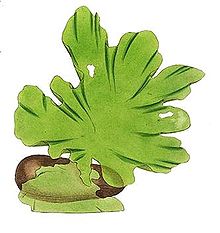| Ulvaria obscura | |
|---|---|

| |
| Scientific classification | |
| (unranked): | Viridiplantae |
| Division: | Chlorophyta |
| Class: | Ulvophyceae |
| Order: | Ulvales |
| Family: | Ulvaceae |
| Genus: | Ulvaria |
| Species: | U. obscura
|
| Binomial name | |
| Ulvaria obscura (Kützing) Gayral ex Bliding
| |
Ulvaria obscura is an intertidal and subtidal benthic marine algae found in temperate and Arctic ocean waters around the world.[1][2]
Ecology[edit]
Ulvaria obscura is a common marine algae, typically identified in algal blooms referred to as "Green Tides".[3][4] The species is distinct in its ability to produce the neurotransmitter dopamine as a herbivore defense mechanism.[5][6] The species has a wide tolerance to various growth conditions, surviving temperatures between 5-29 °C, salinities from freshwater to complete saturation, and grows well under various light intensities.[7] The species growth rate responds to increased dissolved inorganic nitrogen availability, making the species a possible indicator of anthropogenic pollution leading to eutrophication.[8][9][10]
Identification[edit]
The thalli of Ulvaria obscura are bladelike, usually less than 5 cm tall and 8 cm thick, consisting of a single cell layer, and typically have between 2 and 6 pyrenoids per cell.[11] Thalli turn from green to dark brown upon desiccation due to the oxidation of dopamine within the tissues.[6]
References[edit]
- ^ Lindeberg, Mandy; Lindstrom, Sandra. "Ulvaria obscura var. blyttii". Seaweed of Alaska. Cook Inlet Regional Citizens Advisory Council. Retrieved 21 June 2014.
- ^ Latala, Adam (1990). "Photosynthesis and respiration of some marine benthic algae from Spitsbergen". Polar Research. 8 (2): 303–307. doi:10.1111/j.1751-8369.1990.tb00394.x.
- ^ Lee, Dejah J.; Nelson, Timothy A. (2003). "Are "Green Tides" harmful algal blooms? Toxic properties of water-soluble extracts from two bloom-forming macroalgae, Ulva Fenestrata and Ulvaria Obscura (Ulvophyceae)". Journal of Phycology. 39 (5): 874–879. doi:10.1046/j.1529-8817.2003.02157.x. S2CID 42744177.
- ^ Raven, J.A.; Fletcher, R.L.; Taylor, R. (2001). "Preliminary Studies on the Growth of Selected 'Green Tide' Algae in Laboratory Culture: Effects of Irradiance, Temperature, Salinity and Nutrients on Growth Rate". Botanica Marina. 44 (4): 327–336. doi:10.1515/BOT.2001.042.
- ^ Cancilla, DA.; Van Alstyne, KL.; Vyvyan, JR.; Nelson, AV. (2006). "Dopamine functions as an antiherbivore defense in the temperate green alga Ulvaria obscura". Oecologia. 148 (2): 304–311. doi:10.1007/s00442-006-0378-3. PMID 16489461.
- ^ a b Gifford, Sue-Ann; Winans, Amanda K.; Anderson, Katie J.; Van Alstyne, Kathryn L. (2011). "Dopamine release by the green alga Ulvaria obscura after simulated immersion by incoming tides". Marine Biology. 158 (9): 2087–2094. doi:10.1007/s00227-011-1716-5.
- ^ Mathieson, A.C.; Guo, Z. (1992). "Physiological Ecology of Four Ulvoid Green Algae". Botanica Marina. 35 (6): 523–534. doi:10.1515/botm.1992.35.6.523.
- ^ Tjoelker, M.; Nelson, A.V.; Tjoelker, M. (2003). "Seasonal and Spatial Patterns of "Green Tides" (Ulvoid Algal Blooms) and Related Water Quality Parameters in the Coastal Waters of Washington State, USA". Botanica Marina. 46 (3): 263–275. doi:10.1515/BOT.2003.024.
- ^ Nelson, T. A.; Van Alstyne, K. L.; Ribarich, H. (2003). "The Effects of Nitrogen Regime on Growth, [CHN], [DMSP], [Chlorophyll], [Protein] and Nitrogen Uptake Rate in Ulvaria Obscura and Ulva Fenestrata". Journal of Phycology. 38 (1): 29. doi:10.1046/j.1529-8817.38.s1.83.x.
- ^ Nelson, TA; Haberlin, K.; Fredrickson, K.; Simunds, DJ; Buckingham, L; Van Alstyne, KL (2008). "Ecological and physiological controls of species composition in green macroalgal blooms". Ecology. 89 (5): 1287–1298. doi:10.1890/07-0494.1. PMID 18543622.
- ^ Gabrielson, Paul; Widdowson, Thomas; Sandra, Lindstrom; Hawkes, Micheal; Scagel, Robert (2000). Keys to Benthic Marine Algae and Seagrasses of British Columbia, Southeast Alaska, Washington and Oregon. Vancouver, British Columbia: University of British Columbia. pp. 80 & 97. ISBN 0888654669.